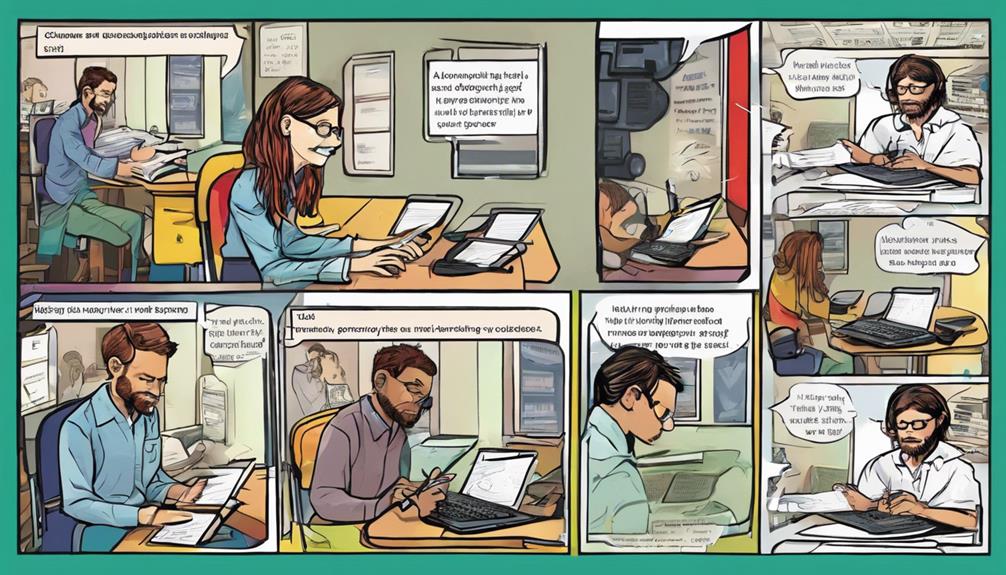Tackling conflicts in relationships with **good communication** brings us closer. Differences often spark conflicts, but facing them head-on strengthens bonds. Listen intently and use “I statements” to express feelings without blame. Owning our emotions and speaking clearly prevents misunderstandings. Recognize triggers and strive for understanding to solve problems. Working together to find solutions **promotes harmony** and connection. Explore these tips to see how they can transform conflict management, leading to more **trust and intimacy**.
Key Takeaways
- Use active listening to fully understand the other person's perspective and show genuine interest.
- Employ 'I statements' to express personal feelings and reduce defensive reactions.
- Take responsibility for your emotions and avoid blame-shifting to promote constructive dialogue.
- Brainstorm solutions together and be willing to compromise for mutually agreeable resolutions.
- Focus on the issue at hand rather than blaming individuals to keep discussions solution-oriented.
Understanding Conflict in Relationships

Conflict in relationships often arises from differences in values, beliefs, goals, and communication styles. When we encounter these differences, it's easy to feel misunderstood or disconnected. However, it's important to remember that conflict itself isn't inherently bad; it's how we handle it that makes the difference.
Effective communication is key to managing these conflicts. By openly discussing our feelings and perspectives, we can gain a better understanding of each other. It's vital that we approach these conversations with empathy and a willingness to listen. Using 'I' statements, such as 'I feel' or 'I think,' can help us express our thoughts without sounding accusatory, which can reduce defensiveness and foster a more constructive dialogue.
In our relationships, unresolved conflicts can lead to misunderstandings and bigger issues down the line. But when we address conflicts head-on, we open the door to learning and growth. This process of exploring our differences can deepen our connections and ultimately strengthen our bonds.
Let's embrace conflict as an opportunity to communicate more effectively, ensuring our relationships become more resilient and enriched by our diverse perspectives.
The Role of Active Listening

Active listening, which demands our full attention and engagement, is vital for grasping each other's perspectives in a relationship. When we're communicating during conflict, it's easy to get caught up in our own emotions and miss what our partner is truly saying. By practicing active listening, we create a space where both parties feel heard and comprehended, which can be transformative in resolving relationship conflict.
We can show we're actively listening by maintaining eye contact and nodding, signaling to our partner that we're fully present. This nonverbal communication encourages them to keep sharing, fostering a deeper connection. Additionally, paraphrasing what our partner says helps clarify our understanding and confirms we're on the same page. For example, saying, 'So, what I hear you saying is…' can go a long way in confirming that we comprehend their perspective.
Active listening isn't just about hearing words; it's about showing genuine interest in our partner's thoughts and feelings. This fosters empathy and mutual respect, vital elements in any relationship. By prioritizing active listening, we can navigate conflicts more effectively, ensuring that our communication during conflict leads to resolution and stronger bonds.
The Power of I Statements

When we use I statements, we express our personal feelings clearly without making the other person feel attacked, which helps reduce defensive reactions.
This approach encourages constructive dialogue, allowing both parties to share their perspectives openly.
Expressing Personal Feelings Clearly
We can express our personal feelings more effectively by using I statements, which help prevent blame and foster open communication. When we say 'I feel upset when the dishes aren't done,' instead of 'You never do the dishes,' we're focusing on our emotions and not pointing fingers. This subtle shift can make a big difference in how our message is received.
Using I statements helps in several ways:
- Ownership of Feelings: We take responsibility for our emotions, which can lead to more constructive conflict resolution.
- Reducing Blame: By focusing on our personal feelings, we avoid making the other person feel attacked, paving the way for open communication.
- Promoting Empathy: When we communicate our feelings clearly, it's easier for others to understand where we're coming from.
- Encouraging Dialogue: I statements invite the other person to share their perspective, fostering a two-way conversation.
Reducing Defensive Reactions
Utilizing I statements empowers us to convey our feelings without triggering defensive reactions from others. When we use I statements, we're focusing on our personal feelings and experiences rather than placing blame. This approach helps to reduce defensiveness, making room for more constructive communication. Instead of saying, "You never listen to me," we might say, "I feel unheard when I'm interrupted." This subtle shift can make a significant difference in how our message is received.
| Blaming Statements | I Statements | Effect |
|---|---|---|
| "You always ignore me." | "I feel ignored when…" | Reduces defensiveness |
| "You never help around here." | "I feel overwhelmed without help." | Promotes constructive communication |
| "You make me so angry." | "I feel angry when…" | Fosters empathy and understanding |
Encouraging Constructive Dialogue
I statements play an important role in encouraging constructive dialogue by allowing us to express our feelings without casting blame. When we use I statements, we focus on our own thoughts and emotions, which can help reduce defensiveness and foster a more empathetic and understanding environment during conflicts.
This communication style is crucial for effective conflict resolution because it promotes a healthier exchange and helps us manage our personal feelings better.
Here's how we can use I statements to improve our communication styles:
- Start with “I feel”: This centers the conversation on our emotions rather than the other person's actions.
- Specify the behavior: Clearly describe the behavior that triggered the feeling without making it sound like an accusation.
- Explain the impact: Articulate how the behavior affects us, providing context to our feelings.
- State your needs: Communicate what we need or hope will change, promoting a solution-focused dialogue.
Taking Responsibility for Emotions

When we take responsibility for our emotions, we acknowledge our personal feelings and express our needs clearly, which helps us navigate conflicts more effectively.
By avoiding blame shifting, we foster an environment of understanding and cooperation.
This approach empowers us to communicate more calmly and constructively, leading to healthier relationships.
Acknowledge Personal Feelings
Taking responsibility for our emotions during conflicts allows us to communicate more effectively and foster healthier interactions. When we acknowledge our personal feelings, we shift from a blame-based approach to one that focuses on understanding and connection.
Using 'I statements' rather than blaming others helps us articulate our emotions without attacking our partner. This change in communication style can transform how we navigate conflicts, showing us that conflict is beneficial when approached constructively.
To better acknowledge our personal feelings, we can:
- Reflect on Emotions: Take time to understand what we're feeling and why.
- Identify Triggers: Recognize what specific actions or words trigger our emotions.
- Manage Calmly: Take deep breaths and remain calm to avoid escalating the situation.
- Communicate Openly: Use 'I statements' to express our feelings and needs without blaming our partner.
Express Needs Clearly
Building on our understanding of personal feelings, we must also express our needs clearly to promote healthier communication during conflicts. When we take responsibility for our emotions, we acknowledge how we feel and manage those feelings without placing blame on others. This approach not only fosters open and honest communication but also helps maintain a calm atmosphere during discussions.
By expressing needs clearly, we can engage in constructive dialogue that allows both parties to understand each other better. For instance, instead of saying, 'You never listen to me,' we can say, 'I feel unheard when you don't acknowledge my opinions.' This shift in language takes responsibility for our emotions and focuses on our own feelings and needs.
Recognizing personal triggers and emotions is vital in this process. When we identify what specifically upsets us, we can communicate more effectively and avoid misunderstandings. Open and honest communication about our needs ensures that both partners are on the same page, paving the way for mutual respect and empathy.
In the end, expressing our needs clearly and taking responsibility for our emotions contributes to a more harmonious relationship, where both individuals feel valued and understood.
Avoid Blame Shifting
We must own our feelings and reactions without blaming others to foster effective communication during conflicts. When we engage in blame shifting, we avoid taking responsibility for our emotions, which can disrupt healthy communication patterns. Instead, reflecting on our feelings and needs can help manage conflicts constructively. Taking responsibility means acknowledging that our reactions are ours to control, and communicating this to our partner calmly and assertively.
Here are four steps to help avoid blame shifting and improve our communication:
- Self-Reflection: Before addressing the conflict, take a moment to reflect on your emotions and identify what you truly feel and need.
- Use “I” Statements: Frame your feelings with “I” statements instead of “You” statements. For example, say, “I feel hurt when…” rather than “You always…”.
- Stay Calm: Approach the conversation with a calm demeanor. This helps in expressing your needs assertively without escalating the conflict.
- Listen Actively: Show empathy by actively listening to your partner's perspective, which fosters mutual understanding and reduces the urge to blame.
Seeking Mutual Understanding

In addressing conflicts, actively listening to our partner's perspective without judgment is vital for seeking mutual understanding. By approaching disagreements with curiosity and a genuine desire to understand our partner's feelings and needs, we open the door to more empathetic communication. It's essential to use 'I statements' when expressing our own feelings, as this helps to reduce defensiveness and keeps the focus on our experiences rather than blaming our partner.
When we take the time to clarify our partner's viewpoints and validate their emotions, it creates a sense of mutual understanding. This doesn't mean we've to agree with everything they say, but acknowledging their feelings can pave the way to finding common ground. It's about showing respect for their perspective and recognizing that their emotions are valid, even if our own differ.
Understanding each other's underlying values and beliefs is foundational to resolving conflicts effectively. When we empathize with our partner, it fosters a deeper connection and cooperation. This mutual understanding helps us navigate disagreements with more patience and compassion, ultimately leading to healthier, more fulfilling relationships.
Strategies for Finding Solutions

After establishing mutual understanding, let's explore practical strategies for finding solutions together. Conflicts are an inevitable part of any relationship, and the way we handle them can be incredibly beneficial for intimate bonds. By embracing a collaborative type of communication, we can find solutions that work for both parties.
Here are four strategies we can use:
- Brainstorm Together: Sit down and list all possible solutions without judgment. This fosters teamwork and opens up a range of options.
- Avoid Blame: Focus on the problem, not the person. When we avoid blame, we create a safe environment for honest dialogue.
- Willingness to Compromise: Be open to give-and-take. Compromise shows respect for each other's needs and perspectives.
- Evaluate and Agree: Go through each option and discuss its pros and cons. Aim for a solution that's acceptable and beneficial for both.
Using these strategies, we can turn conflicts into opportunities for growth.
The ultimate goal is to find solutions that strengthen our relationship, showing that effective problem-solving isn't just about resolving issues but also about deepening our connection.
Frequently Asked Questions
How to Navigate Conflict in a Relationship?
When we navigate conflict in a relationship, we need to actively listen to our partner's perspective, using 'I' statements to express our feelings without blaming.
It's essential to manage our emotions and reactions, asking clarifying questions to truly understand each other.
How to Communicate Better in a Relationship in Conflict?
When we had a disagreement about finances, we used 'I' statements like, 'I feel stressed about our budget.'
We practiced active listening, ensuring we didn't interrupt each other.
We managed our emotions by taking deep breaths and asking clarifying questions to understand each other's needs.
Focusing on finding a resolution rather than blaming each other helped us communicate better and strengthen our relationship.
What Is a Helpful Technique for Managing Conflicts in Communication?
A helpful technique for managing conflicts in communication is using 'I' statements. When we express our feelings and thoughts without blaming, it fosters empathy and understanding.
Saying, 'I feel hurt when…' instead of 'You always…' helps us take responsibility for our emotions and encourages the other person to listen. This approach creates a safe space for both parties to share openly, leading to more constructive dialogue and resolution.
How to Deal With Poor Communication and Conflict in an Unhealthy Relationship?
To address poor communication and conflict in an unhealthy relationship, we need to initiate open dialogue, actively listen, and address underlying issues with patience.
Seeking couples therapy can provide us with tools to improve our communication patterns and resolve conflicts effectively.
By focusing on mutual understanding and emotional well-being, we can work towards rebuilding trust and fostering a healthier relationship dynamic.
Let's commit to healing together.
How Can Effective Communication Help in Resolving Relationship Conflicts?
When facing relationship conflicts, practical strategies for empathy communication can be highly effective. By actively listening, acknowledging the other person’s feelings, and expressing empathy, individuals can create a more open and understanding dialogue. This can lead to resolution and a stronger, more connected relationship.
Conclusion
In managing conflict in our relationships, we've discovered the magic of mindful communication. By actively listening and using 'I statements,' we express our feelings without blame.
When we take responsibility for our emotions and aim for mutual understanding, we create a foundation for finding solutions. It's not always smooth sailing, but with patience and practice, we can turn turbulent talks into meaningful moments.
Let's commit to connecting and communicating with compassion.











